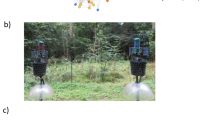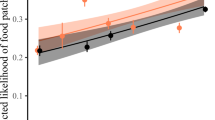Abstract
Warning signals are an effective defence strategy for aposematic prey, but only if they are recognized by potential predators. If predators must eat prey to associate novel warning signals with unpalatability, how can aposematic prey ever evolve? Using experiments with great tits (Parus major) as predators, we show that social transmission enhances the acquisition of avoidance by a predator population. Observing another predator’s disgust towards tasting one novel conspicuous prey item led to fewer aposematic than cryptic prey being eaten for the predator population to learn. Despite reduced personal encounters with unpalatable prey, avoidance persisted and increased over subsequent trials. Next we use a mathematical model to show that social transmission can shift the evolutionary trajectory of prey populations from fixation of crypsis to fixation of aposematism more easily than was previously thought. Therefore, social information use by predators has the potential to have evolutionary consequences across ecological communities.
This is a preview of subscription content, access via your institution
Access options
Access Nature and 54 other Nature Portfolio journals
Get Nature+, our best-value online-access subscription
$29.99 / 30 days
cancel any time
Subscribe to this journal
Receive 12 digital issues and online access to articles
$119.00 per year
only $9.92 per issue
Buy this article
- Purchase on Springer Link
- Instant access to full article PDF
Prices may be subject to local taxes which are calculated during checkout





Similar content being viewed by others
References
Poulton, E. B. The Colours of Animals: Their Meaning and Use Especially Considered in the Case of Insects (Kegan Paul, Trench, Trübner & Co., London, 1890).
Puurtinen, M. & Kaitala, V. Conditions for the spread of conspicuous warning signals: a numerical model with novel insights. Evolution 60, 2246–2256 (2006).
Ruxton, G. D. & Sherratt, T. N. Aggregation, defence and warning signals: the evolutionary relationship. Proc. R. Soc. B Biol. Sci. 273, 2417–2424 (2006).
Skelhorn, J., Halpin, C. G. & Rowe, C. Learning about aposematic prey. Behav. Ecol. 27, 955–964 (2016).
Lindström, L., Alatalo, R. V., Mappes, J., Riipi, M. & Vertainen, L. Can aposematic signals evolve by gradual change? Nature 397, 249–251 (1999).
Gittleman, J. L. & Harvey, P. H. Why are distasteful prey not cryptic? Nature 286, 149–150 (1980).
Exnerová, A. et al. Avoidance of aposematic prey in European tits (Paridae): learned or innate? Behav. Ecol. 18, 148–156 (2007).
Mappes, J., Kokko, H., Ojala, K. & Lindström, L. Seasonal changes in predator community switch the direction of selection for prey defences. Nat. Commun. 5, 5016 (2014).
Longson, C. G. & Joss, J. M. P. Optimal toxicity in animals: predicting the optimal level of chemical defences. Funct. Ecol. 20, 731–735 (2006).
Stevens, M. & Ruxton, G. D. D. Linking the evolution and form of warning coloration in nature. Proc. R. Soc. B Biol. Sci. 279, 417–426 (2012).
Marples, N. M., Kelly, D. J. & Thomas, R. J. Perspective: the evolution of warning coloration is not paradoxical. Evolution 59, 933–940 (2005).
Riipi, M., Alatalo, R. V. & Lindström, L. Multiple benefits of gregariousness cover detectability costs in aposematic aggregations. Nature 413, 512–514 (2001).
Marples, N. M. & Mappes, J. Can the dietary conservatism of predators compensate for positive frequency dependent selection against rare, conspicuous prey? Evol. Ecol. 25, 737–749 (2011).
McMahon, K. & Marples, N. Reduced dietary conservatism in a wild bird in the presence of intraspecific competition. J. Avian Biol. 48, 448–454 (2017).
Lindström, L., Alatalo, R. V. & Mappes, J. Reactions of hand-reared and wild-caught predators toward warningly colored, gregarious, and conspicuous prey. Behav. Ecol. 10, 317–322 (1999).
Endler, J. A. & Mappes, J. Predator mixes and the conspicuousness of aposematic signals. Am. Nat. 163, 532–547 (2004).
Dall, S. R. X., Giraldeau, L.-A., Olsson, O., McNamara, J. M. & Stephens, D. W. Information and its use by animals in evolutionary ecology. Trends Ecol. Evol. 20, 187–193 (2005).
Lynn, S. K. Learning to avoid aposematic prey. Anim. Behav. 70, 1221–1226 (2005).
Swynnerton, C. F. M. Birds in relation to their prey: experiments on wood hoopoes, small hornbills and a babbler. J. S. Afr. Ornithol. Union 11, 32–108 (1915).
van de Waal, E., Borgeaud, C. & Whiten, A. Potent social learning and conformity shape a wild primate’s foraging decisions. Science 340, 483–485 (2013).
Landová, E., Hotová Svádová, K., Fuchs, R., Štys, P. & Exnerová, A. The effect of social learning on avoidance of aposematic prey in juvenile great tits (Parus major). Anim. Cogn. 20, 855–866 (2017).
Snowdon, C. T. & Boe, C. Y. Social communication about unpalatable foods in tamarins (Saguinus oedipus). J. Comp. Psychol. 117, 142–148 (2003).
Mason, J. R. & Reidinger, R. Observational learning of food aversions in red-winged blackbirds (Agelaius phoeniceus). Auk 99, 548–554 (1982).
Fryday, S. & Greig-Smith, P. The effects of social learning on the food choice of the house sparrow (Passer domesticus). Behaviour 128, 281–300 (1994).
Johnston, A. N. B., Burne, T. H. J. & Rose, S. P. R. Observation learning in day-old chicks using a one-trial passive avoidance learning paradigm. Anim. Behav. 56, 1347–1353 (1998).
Skelhorn, J. Colour biases are a question of conspecifics’ taste. Anim. Behav. 81, 825–829 (2011).
Harvey, P. H., Bull, J. J., Pemberton, M. & Paxton, R. J. The evolution of aposematic coloration in distasteful prey: a family model. Am. Nat. 119, 710–719 (1982).
Alatalo, R. V. & Mappes, J. Tracking the evolution of warning signals. Nature 382, 708–710 (1996).
Lindström, L., Lyytinen, A., Mappes, J. & Ojala, K. Relative importance of taste and visual appearance for predator education in Müllerian mimicry. Anim. Behav. 72, 323–333 (2006).
Sillén-Tullberg, B. Higher survival of an aposematic than of a cryptic form of a distasteful bug. Oecologia 67, 411–415 (1985).
Marchetti, C. & Drent, P. J. Individual differences in the use of social information in foraging by captive great tits. Anim. Behav. 60, 131–140 (2000).
Aplin, L. M. et al. Experimentally induced innovations lead to persistent culture via conformity in wild birds. Nature 518, 538–541 (2015).
Hämäläinen, L., Rowland, H. M., Mappes, J. & Thorogood, R. Can video playback provide social information for foraging blue tits? PeerJ 5, e3062 (2017).
Saitou, T. Ecological study of social organization in the great tit, Parus major L. III. Home range of the basic flocks and dominance relationship of the members in a basic flock. J. Yamashina Inst. Ornithol. 11, 149–171 (1979).
Lee, T. J. & Speed, M. P. The effect of metapopulation dynamics on the survival and spread of a novel, conspicuous prey. J. Theor. Biol. 267, 319–29 (2010).
Grüter, C. & Leadbeater, E. Insights from insects about adaptive social information use. Trends Ecol. Evol. 29, 177–184 (2014).
White, S. L. & Gowan, C. Social learning enhances search image acquisition in foraging brook trout. Environ. Biol. Fishes 97, 523–528 (2014).
Kis, A., Huber, L. & Wilkinson, A. Social learning by imitation in a reptile (Pogona vitticeps). Anim. Cogn. 18, 325–331 (2015).
Galef, B. G. & Giraldeau, L.-A. Social influences on foraging in vertebrates: causal mechanisms and adaptive functions. Anim. Behav. 61, 3–15 (2001).
Heyes, C. M. Social learning in animals: categories and mechanisms. Biol. Rev. 69, 207–231 (1994).
Skelhorn, J. & Rowe, C. Taste-rejection by predators and the evolution of unpalatability in prey. Behav. Ecol. Sociobiol. 60, 550–555 (2006).
Olsson, A. & Phelps, E. A. Social learning of fear. Nat. Neurosci. 10, 1095–1102 (2007).
Sasvári, L. & Hegyi, Z. How mixed-species foraging flocks develop in response to benefits from observational learning. Anim. Behav. 55, 1461–1469 (1998).
Farine, D. R., Garroway, C. J. & Sheldon, B. C. Social network analysis of mixed-species flocks: exploring the structure and evolution of interspecific social behaviour. Anim. Behav. 84, 1271–1277 (2012).
Nokelainen, O., Valkonen, J., Lindstedt, C. & Mappes, J. Changes in predator community structure shifts the efficacy of two warning signals in arctiid moths. J. Anim. Ecol. 83, 598–605 (2014).
Farine, D. R., Montiglio, P. & Spiegel, O. From individuals to groups and back: the evolutionary implications of group phenotypic composition. Trends Ecol. Evol. 30, 609–621 (2015).
Beckmann, C., Crossland, M. R. & Shine, R. Responses of Australian wading birds to a novel toxic prey type, the invasive cane toad Rhinella marina. Biol. Invasions 13, 2925–2934 (2011).
Cremona, T., Spencer, P., Shine, R. & Webb, J. K. Avoiding the last supper: parentage analysis indicates multi-generational survival of re-introduced ‘toad-smart’ lineage. Conserv. Genet. 18, 1475–1480 (2017).
Thorogood, R. & Davies, N. B. Cuckoos combat socially transmitted defenses of reed warbler hosts with a plumage polymorphism. Science 337, 578–580 (2012).
Pruitt, J. N. et al. Behavioral hypervolumes of predator groups and predator–predator interactions shape prey survival rates and selection on prey behavior. Am. Nat. 189, 254–266 (2017).
Orell, M. Population fluctuations and survival of great tits Parus major dependent on food supplied by man in winter. Ibis 131, 112–127 (1989).
Snijders, L., Naguib, M. & van Oers, K. Dominance rank and boldness predict social attraction in great tits. Behav. Ecol. 28, 398–406 (2017).
Guillette, L. M. & Healy, S. D. The roles of vocal and visual interactions in social learning zebra finches: a video playback experiment. Behav. Process. 139, 43–49 (2017).
R Development Core Team R: A Language and Environment for Statistical Computing (R Foundation for Statistical Computing, Vienna, 2017).
Bates, D., Mächler, M., Bolker, B. & Walker, S. Fitting linear mixed-effects models using lme4. J. Stat. Softw. 67, 1–48 (2015).
Acknowledgements
We are grateful to N. Boogert for suggesting the video playback method, D. Abondano Almeida, S. Burdillat and M. Brain for help with the experiments, J. Valkonen for valuable technical help, V. Franks for providing illustrations, and H. Nisu and staff at the Konnevesi Research Station for hosting the experiments and caring for the birds. P. Klopfer provided helpful discussion and the manuscript was improved by comments from N. Boogert, L. Hämäläinen and M. Puurtinen. R.T. was funded by an Independent Research Fellowship from the Natural Environment Research Council (NE/K00929X/1). J.M. and H.K. were supported by the Academy of Finland Centre of Excellence in Biological Interactions (project number 252411) and H.K. was additionally supported by the Swiss National Foundation.
Author information
Authors and Affiliations
Contributions
R.T. conceived the project and designed and conducted the experiments and analyses. J.M. designed the experiments and assisted with the analyses. H.K. conceived and conducted the modelling. All authors wrote the manuscript.
Corresponding author
Ethics declarations
Competing interests
The authors declare no competing financial interests.
Additional information
Publisher’s note: Springer Nature remains neutral with regard to jurisdictional claims in published maps and institutional affiliations.
Supplementary information
Supplementary Information
Supplementary Methods, Supplementary References, Supplementary Figures 1–3, and Supplementary Tables 1–2.
Supplementary Video 1
Example of social information treatment from validation experiment.
Supplementary Video 2
Example of control from validation experiment.
Supplementary Video 3
Example of social information treatment from predation experiment.
Supplementary Video 4
Example of control from predation experiment.
Rights and permissions
About this article
Cite this article
Thorogood, R., Kokko, H. & Mappes, J. Social transmission of avoidance among predators facilitates the spread of novel prey. Nat Ecol Evol 2, 254–261 (2018). https://doi.org/10.1038/s41559-017-0418-x
Received:
Accepted:
Published:
Issue Date:
DOI: https://doi.org/10.1038/s41559-017-0418-x
This article is cited by
-
Effects of predator associative learning and innate aversion on mimicry complexes
Evolutionary Ecology (2023)
-
Social information-mediated population dynamics in non-grouping prey
Behavioral Ecology and Sociobiology (2022)
-
Social transmission in the wild can reduce predation pressure on novel prey signals
Nature Communications (2021)
-
Psychological Aposematism: An Evolutionary Analysis of Suicide
Biological Theory (2020)
-
The reach of gene–culture coevolution in animals
Nature Communications (2019)



